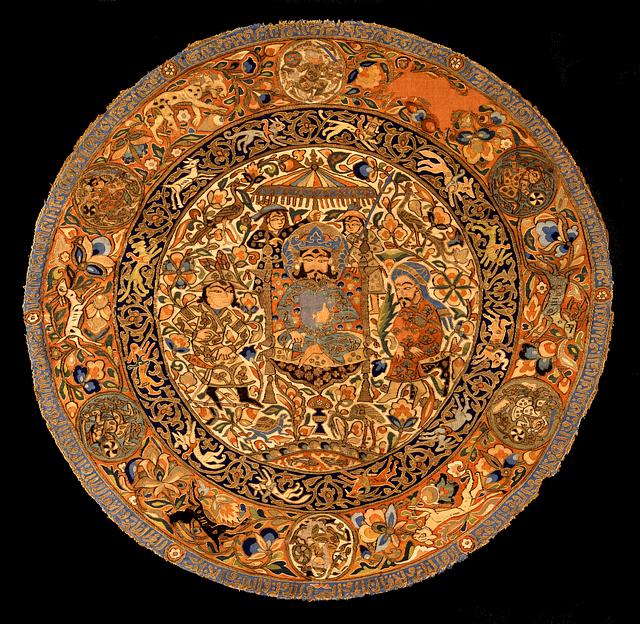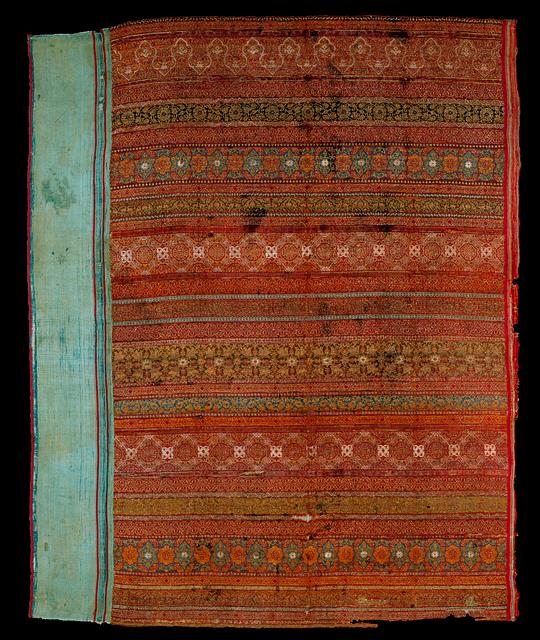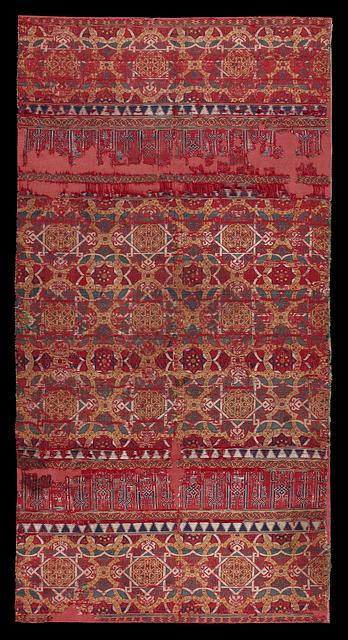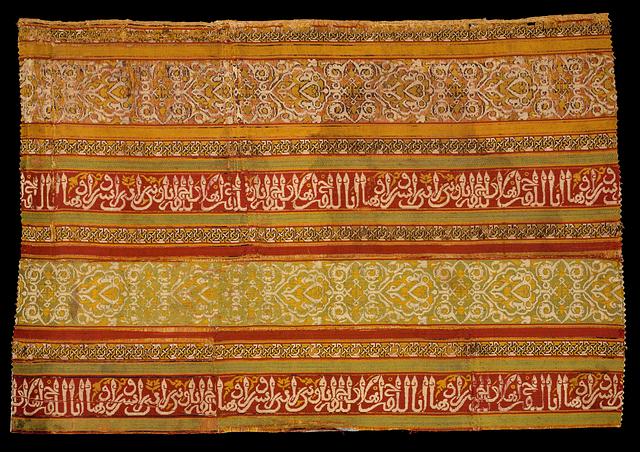Venstre halvdel af en lampasvævet tekstilbane, af silke, forgyldt papir og forgyldt dyremembran
Kina eller det østislamiske område; 14. århundredes 1. halvdel
H: 228: B: 63,5 cm
Inventarnummer 40/1997
Med sine stiliserede søjler, modstillede haner i medaljoner, mindre medaljoner med drager og fønikser samt en rig og kompliceret baggrund for disse, er dette måske det mest pragtfulde af museets lampasvævede tekstiler fra den mongolske periode. Motiverne stammer både fra vest og øst, men anvendelsen af papir snarere end animalsk membran til ”guldtråden” kunne indikere, at tekstilet blev vævet i den østlige del af det mongolske verdensrige.
Sammen med en række andre stofbaner, der i dag befinder sig på Museum of Islamic Art i Qatar har denne oprindeligt udgjort væggene i et telt eller en baldakin.
Sammen med en række andre stofbaner, der i dag befinder sig på Museum of Islamic Art i Qatar har denne oprindeligt udgjort væggene i et telt eller en baldakin.
Publiceret i
Publiceret i
Kjeld von Folsach: Kunst fra islams verden i Davids Samling, København 2001, kat.nr. 641;
Linda Komaroff og Stefano Carboni (red.): The legacy of Genghis Khan: courtly art and culture in Western Asia, 1256-1353, Metropolitan Museum of Art, New York 2002, fig. 42, s. 45, kat.nr. 73, s. 261;
Caroline Kim: “The treasures of Genghis Khan” i Humanities: The Magazine of the National Endowment for the Humanities, 2002, September/October, s. 12;
David Kamansky (red.): Wooden wonders: Tibetan furniture in secular and religious life, Pacific Asia Museum, Pasadena 2004, fig. 19, s. 81;
Sheila S. Blair: “East meets West under the Mongols” i The Silk Road, 3:2, 2005, s. 31-32;
Yuka Kadoi: “Aspects of frescoes in fourteenth-century Iranian architecture: the case of Yazd” i Iran, 43, 2005, fig. 20, s. 231;
Sheila S. Blair og Jonathan M. Bloom (red.): Cosmophilia. Islamic Art from the David Collection, Copenhagen, McMullen Museum of Art, Boston College, Boston 2006, kat.nr. 12;
Yuka Kadoi: Islamic chinoiserie: the art of Mongol Iran, Edinburgh 2009, fig. 1.14, s. 31;
Kjeld von Folsach: “A set of silk panels from the Mongol period” i Sheila Blair og Jonathan Bloom (red.): God is beautiful and loves beauty: the object in Islamic art and culture, New Haven 2013, fig. 208, s. 218-219 og figs. 213, 214, 215, og s. 229, fig. 218e;
Yuka Kadoi : “Chinese and Turko-Mongol elements in Ilkhanid and Timurid arts. Part 1: The Mongols (c. 1250-1350)” i Finbarr Barry Flood, Gülru Necipoglu (red.): A companion to Islamic art and architecture, B. 2, From the Mongols to modernism, Hoboken 2017, s. 639, fig. 25.1;
Eiren Shea: “Textile as traveller: the transmission of inscribed robes across Asia in the twelfth through fourteenth centuries” i Arts asiatiques, 73, 2018, fig. 9, s. 34-35;
Patricia Blessing, Elizabeth Dospel Williams, Eiren L. Shea: Medieval textiles across Eurasia, c. 300–1400, Cambridge 2023, fig. 60 og s. 71;
Linda Komaroff og Stefano Carboni (red.): The legacy of Genghis Khan: courtly art and culture in Western Asia, 1256-1353, Metropolitan Museum of Art, New York 2002, fig. 42, s. 45, kat.nr. 73, s. 261;
Caroline Kim: “The treasures of Genghis Khan” i Humanities: The Magazine of the National Endowment for the Humanities, 2002, September/October, s. 12;
David Kamansky (red.): Wooden wonders: Tibetan furniture in secular and religious life, Pacific Asia Museum, Pasadena 2004, fig. 19, s. 81;
Sheila S. Blair: “East meets West under the Mongols” i The Silk Road, 3:2, 2005, s. 31-32;
Yuka Kadoi: “Aspects of frescoes in fourteenth-century Iranian architecture: the case of Yazd” i Iran, 43, 2005, fig. 20, s. 231;
Sheila S. Blair og Jonathan M. Bloom (red.): Cosmophilia. Islamic Art from the David Collection, Copenhagen, McMullen Museum of Art, Boston College, Boston 2006, kat.nr. 12;
Yuka Kadoi: Islamic chinoiserie: the art of Mongol Iran, Edinburgh 2009, fig. 1.14, s. 31;
Kjeld von Folsach: “A set of silk panels from the Mongol period” i Sheila Blair og Jonathan Bloom (red.): God is beautiful and loves beauty: the object in Islamic art and culture, New Haven 2013, fig. 208, s. 218-219 og figs. 213, 214, 215, og s. 229, fig. 218e;
Yuka Kadoi : “Chinese and Turko-Mongol elements in Ilkhanid and Timurid arts. Part 1: The Mongols (c. 1250-1350)” i Finbarr Barry Flood, Gülru Necipoglu (red.): A companion to Islamic art and architecture, B. 2, From the Mongols to modernism, Hoboken 2017, s. 639, fig. 25.1;
Eiren Shea: “Textile as traveller: the transmission of inscribed robes across Asia in the twelfth through fourteenth centuries” i Arts asiatiques, 73, 2018, fig. 9, s. 34-35;
Patricia Blessing, Elizabeth Dospel Williams, Eiren L. Shea: Medieval textiles across Eurasia, c. 300–1400, Cambridge 2023, fig. 60 og s. 71;

.jpg)


.jpg)



